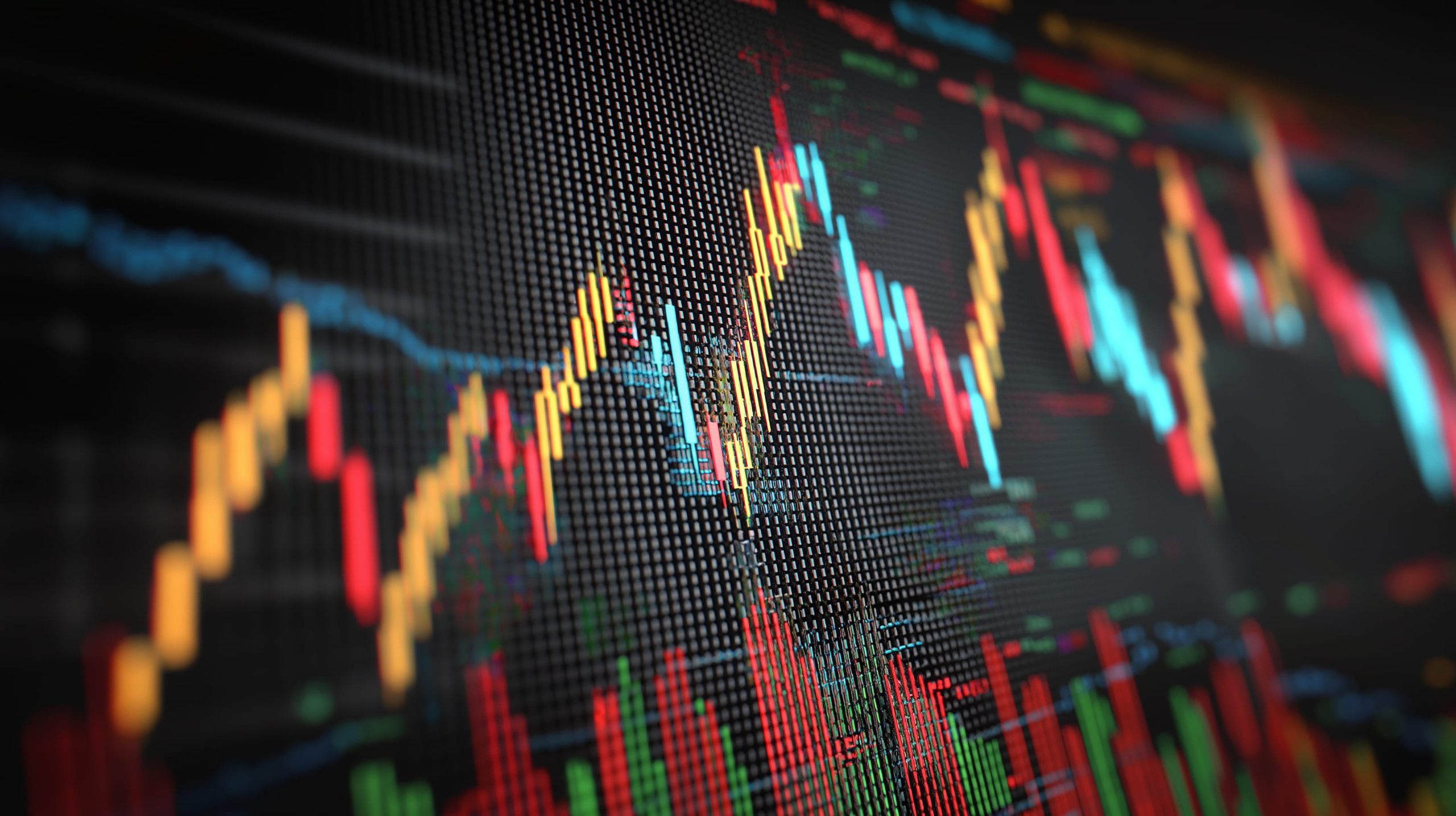Key Highlights (October 7, 2025)
- Markets Dip After Record Highs: All three major U.S. indices pulled back after Monday’s record closes. The S&P 500 fell about 0.4%, the Nasdaq Composite lost 0.7%, and the Dow Jones slipped 0.2% [1]. This marked the S&P’s first decline in over a week amid renewed caution on Wall Street.
- Tech Leads Losses: Technology stocks led the retreat. Software giant Oracle plunged roughly 5–6% on worries about its cloud business [2], and Tesla sank about 3%, giving back some of the prior day’s jump ahead of its product event [3]. Chipmakers also stumbled, with names like Broadcom and Lam Research down 2–4% [4].
- Gold Soars to Record: Investors flocked to safe havens. Gold futures breached $4,000 per ounce for the first time ever [5] – a historic high – as inflation worries and geopolitical tensions drove demand for the precious metal. (Bitcoin also hovered near record levels around $120K.)
- Select Winners: Not all stocks fell. Constellation Brands jumped about 3–4% after delivering better-than-expected quarterly sales [6]. IBM hit an all-time high, rising over 2% on news of a partnership with AI startup Anthropic [7]. Advanced Micro Devices (AMD) extended its surge – up another ~3% after a 24% jump Monday on its blockbuster AI chip deal with OpenAI [8].
- Fed Easing Hopes: Federal Reserve expectations underpinned the market. Traders are betting the Fed will cut interest rates by 0.25% at its meeting later this month [9], given recent signs of a cooling job market. A Fed official even warned that keeping policy too tight now is “risky,” hinting at a dovish stance.
- Political Uncertainty: The U.S. government shutdown dragged into a second week, delaying key economic reports (like the jobs data) and adding a layer of uncertainty [10]. While investors largely shrugged it off in recent sessions, the impasse – along with other global tensions – has started to temper risk appetite and boost safe-haven assets.
Major Indexes Retreat from Record Highs
Wall Street’s major indexes gave back ground after a multi-day rally that culminated in fresh records to start the week. On Monday (Oct 6), the S&P 500 and Nasdaq Composite each notched all-time closing highs, buoyed by excitement over big tech deals – notably AMD’s partnership with OpenAI that sent its stock soaring nearly 24% [11]. But by Tuesday, the momentum faltered. The S&P 500 slipped roughly 0.4%, the Nasdaq about 0.7%, and the Dow 0.2%, based on Tuesday’s close [12]. In point terms, the Dow shed just over 100 points while the tech-heavy Nasdaq lost over 200 points.
This pullback broke a 7-session winning streak for the S&P, as investors paused to digest new concerns. One red flag came from the New York Fed’s latest survey, which found inflation expectations ticking up (one-year outlook rose to 3.4% from 3.2% in August) [13]. That report “highlighted simmering anxiety” about the job market and economy [14], putting a damper on the bullish sentiment. Still, despite today’s dip, the market’s recent advance has been remarkable – eight of the past ten sessions were winners – a sign of resilient risk appetite until now. “It certainly feels like momentum is on the side of investors over the last few days,” noted Mona Mahajan, an investment strategist at Edward Jones [15], though Tuesday’s setback showed that sentiment can quickly change.
Tech Stock Tumble Drags on the Market
Technology and growth stocks – the driving force behind the 2025 rally – turned into the biggest weight on the market today. The S&P 500’s tech sector dropped about 0.9% [16], the steepest decline among major groups. A few high-flying tech names hit air pockets: Oracle (ORCL) shares plunged over 5% after reports suggested trouble in its cloud computing unit, including thinner profit margins and unexpected costs in its AI ventures [17]. That news spooked investors about the sustainability of the recent AI-driven boom. Similarly, Microsoft and Broadcomeach fell around 1–2%, and chip-equipment maker Lam Research slid over 4% [18]. The tech slump pulled the Nasdaq Composite nearly 1% lower on the day.
Other growth sectors also felt the pain. Consumer discretionary stocks sank about 1.4% – the worst of any S&P sector – weighed down by a drop in Tesla (TSLA) [19]. Tesla’s stock had surged 5.5% Monday after the company teased a major product announcement, but on Tuesday it gave back roughly 3–4% [20]. Traders took profits as Tesla prepared to unveil a lower-cost Model Y SUV, a move that could boost long-term sales but was already anticipated by the market. Amazon (AMZN) shares also ticked down slightly as the e-commerce giant kicked off its “Prime Big Deal Days” sales event [21], indicating consumers’ response (and its impact on Amazon’s Q4 revenues) will be closely watched.
Sector Performance: Winners & Losers
Market weakness was broad-based, but some sectors held up better than others. In addition to tech (-0.9%) and consumer discretionary (-1.4%) lagging [22] [23], interest-rate-sensitive segments were mixed. Financial stocks edged down only ~0.2% [24], relatively resilient as bond yields eased slightly. The 10-year U.S. Treasury yield hovered around 4.12%, down from recent highs of about 4.16% [25], which gave banks and insurers a breather. Energy stocks also dipped – giants ExxonMobil and Chevron each fell roughly 0.8% on the day – as oil prices softened to ~$61–62 a barrel [26]. Ample global oil supply and only token output cuts from OPEC+ have eased supply concerns, taking some pressure off energy prices [27].
Defensive areas like consumer staples, healthcare, and utilities saw more modest declines (generally under 1%). Investors did not flee into these havens en masse, but their relative stability hints at some rotation toward safety. Notably, one classic defensive asset – gold – had a standout day, as discussed below. Overall, every S&P sector closed in the red, a reflection that Tuesday’s pullback, while led by tech, was a market-wide cooldown after the recent run-up.
Safe Havens Surge as Gold Hits Historic High
When uncertainty rises, money often flows into safer assets – and that’s exactly what happened today. Gold prices skyrocketed to record levels, grabbing headlines as a symbol of investor caution. December gold futures jumped above $4,000 per ounce for the first time ever, touching roughly $4,005 at the peak [28]. The metal ended around $3,990, up 0.3% on the day [29] and nearly 50% higher year-to-date [30]. This all-time high for gold underscores the demand for a hedge amid “ongoing inflation pressures and geopolitical tensions” [31]. Traders cited a mix of factors – rising U.S. deficits, war jitters overseas, and central banks buying gold – as fuel for the surge. Veteran investor Ray Dalio even advised holding a chunk of portfolios in gold as a “powerful hedge when traditional assets fall,” according to remarks published today [32].
Other safe-haven and alternative assets also shined. The U.S. dollar ticked higher (the dollar index up 0.3% to ~98.4) as investors sought stability [33]. Cryptocurrency has been on a tear too – Bitcoin recently breached $125,000for the first time [34] – though it pulled back a few percent today to just under $122K [35]. In the bond market, prices climbed, nudging yields down: the benchmark 10-year Treasury yield eased to ~4.12% from 4.16% Monday [36], reflecting bets that upcoming Fed rate cuts will relieve pressure on interest rates [37]. Taken together, these moves show a market rotating (at least temporarily) toward safety. The spike in gold, especially, signals that investors are hedging against uncertainty, whether stemming from economic worries or global events.
Top Gainers and Losers of the Day
Despite the overall market dip, a few stocks scored big gains thanks to company-specific catalysts, while others saw sharp falls. Here are some of the day’s notable winners and losers:
Top Gainers:
- Trilogy Metals (TMQ): +216% – Skyrocketed more than threefold after the White House announced plans to take a 10% stake in the small-cap mining firm to support a major Alaskan minerals project [38].
- AppLovin (APP): +6.9% – Led the S&P 500, rebounding after an SEC investigation scare. The mobile-app company surged ~7%, recouping nearly half of yesterday’s losses, as analysts downplayed regulatory concerns [39].
- Constellation Brands (STZ): +3.8% – The beer and spirits maker jumped on earnings. It reported a smaller sales dip than expected and upbeat profits, lifting shares by nearly 4% [40].
- IBM (IBM): +2.1% – Hit a record high. The Dow blue-chip gained over 2% after IBM unveiled a partnership to integrate Anthropic’s AI technology (Claude chatbot) into its enterprise software [41].
- Advanced Micro Devices (AMD): +2.9% – Extended rally. The chipmaker continued to climb following Monday’s massive 24% surge on its landmark deal to supply AI chips to OpenAI [42]. A slew of analyst upgrades and price target hikes also boosted AMD shares.
Top Losers:
- Ford (F): –7% – A surprise factory setback hit the automaker. A fire at a key aluminum parts supplier will disrupt Ford’s pickup truck production for months, according to a report, sending Ford stock down sharply [43].
- Oracle (ORCL): –5.8% – The software giant plunged almost 6% as investors reacted to reports of cloud segment troubles (lower margins and costly AI investments) that could hurt future earnings [44].
- Lam Research (LRCX): –4.2% – Shares of this semiconductor equipment maker slid over 4%. Analysts noted some profit-taking in chip stocks and ongoing concerns that U.S. export curbs on China could dent 2026 sales for chip suppliers [45] [46].
- Tesla (TSLA): –3.7% – The EV leader’s stock fell about 3–4%, cooling off after Monday’s rally. Anticipation of Tesla’s upcoming Model Y launch event wasn’t enough to sustain the prior day’s gains [47], as traders “sold the news” ahead of the reveal.
- Broadcom (AVGO): –2.4% – The chip and infrastructure software firm dropped ~2–3%. Broadcom has been a big beneficiary of the AI boom, but high valuations and Oracle’s cloud warning contributed to some rotation out of these shares today [48].
(Percentage changes are approximate. Stock symbols: TMQ = Trilogy Metals, APP = AppLovin, STZ = Constellation Brands, etc.)
Company News Roundup: Earnings and Deals Move Stocks
A flurry of company-specific news drove many of the outsized moves above. On the earnings front, Constellation Brands (STZ) stood out with results that reassured investors. The Corona and Modelo beer parent reported only a slight dip in quarterly sales – much better than feared – and maintained healthy profits [49]. Though the company trimmed its full-year outlook citing “ongoing elevated concern” among some consumer groups, the stock popped nearly 4% on relief that core demand is holding up [50] [51]. In contrast, Levi Strauss (not among top movers) issued a cautious forecast in apparel, hinting at mixed consumer trends. Overall, as the quarterly earnings season kicks off in earnest soon, traders are rewarding companies that beat expectations in this uncertain environment.
In the tech world, Oracle (ORCL) made waves for the wrong reasons. Its stock tumble followed a report that Oracle’s cloud services are underperforming on margins, and that the company may even be losing money on some AI cloud deals (such as renting high-end Nvidia chips to customers at a loss) [52]. This raised broader concerns about the profitability of the cloud/AI arms race that has fueled tech stocks. Oracle’s slump weighed on sentiment across big-cap software names. On the positive side, IBM (IBM) showed how legacy tech can join the AI frenzy: its new tie-up with AI startup Anthropic (an OpenAI rival) will bring cutting-edge AI models into IBM’s enterprise offerings, which investors cheered by sending IBM stock to a record high [53].
Deal-making news also moved markets. Advanced Micro Devices (AMD), fresh off Monday’s announcement of a multi-billion-dollar chip partnership with OpenAI, climbed another 3%. The AMD-OpenAI deal – which even gives OpenAI an option to take a stake in AMD – has been called a potential game-changer that could funnel huge AI workloads (and revenue) to AMD [54] [55]. That optimism spilled over to other chip stocks earlier in the week, though some, like Lam Research, pulled back today on regulatory worries [56]. Elsewhere, Tesla (TSLA) remained in focus as it hosted an event to unveil a more affordable Model Y. The stock’s 5% jump on Monday (when the event was teased) and drop today illustrate the classic “buy the rumor, sell the news” pattern [57]. Still, if Tesla’s new model succeeds in widening its customer base, it could be a longer-term positive. And in a surprising development outside the tech realm, tiny Trilogy Metals (TMQ) saw its U.S.-listed shares triple in value after the U.S. government announced an investment to help develop the company’s Alaska mining project [58]. The move, part of a strategy to secure critical minerals, shows how policy decisions can create big winners in individual stocks almost overnight.
Not to be overlooked, Ford Motor (F) issued a reminder that old-fashioned industrial challenges can roil stocks too. Ford plunged 7% after The Wall Street Journal reported a fire at one of its major suppliers, which produces aluminum parts for Ford’s bestselling F-Series trucks [59]. The damage will curtail truck production for potentially months – a blow to Ford’s earnings because the F-Series is a profit engine. The incident highlights supply chain vulnerabilities that still linger in the post-pandemic era. Ford’s slump dragged on the broader auto sector and was one reason the Dow Jones index underperformed its peers on the day.
Economic News and Fed Policy Signals
Macro-economic factors loomed large in investors’ minds, even as few major data releases occurred (thanks in part to the government shutdown). A key update came from the New York Federal Reserve’s consumer survey, which showed Americans’ inflation expectations nudging higher – anticipating 3.4% inflation a year from now, up from 3.2% in the last survey [60]. While one data point isn’t panic-worthy, any uptick in expected inflation makes markets nervous, because it could complicate the Federal Reserve’s path to easing policy. It also hints that consumers feel price pressures remain sticky. Compounding the cautious mood was the labor market: “The bottom line is that the labor market is at a standstill,” observed Torsten Slok, chief economist at Apollo Global Management, noting recent signs of hiring slowing down [61]. Indeed, private payroll reports and ISM indices last week suggested the jobs market is cooling [62] [63], which in turn has bolstered hopes that the Fed will pivot to rate cuts.
All eyes are on the Federal Reserve’s next meeting at the end of October. Investor expectations of a rate cut have surged – futures markets are pricing in about a 95% chance that the Fed will cut interest rates by 0.25% (25 basis points) at that meeting [64]. This would be the Fed’s second cut this year (following a series of aggressive rate hikes in 2022–2023). The rationale: with inflation appearing to moderate and the job market softening, the Fed has cover to gently loosen monetary policy to support growth. In fact, Federal Reserve Governor Stephen Miran – a voting member of the Fed’s board – reiterated a dovish stance on Tuesday, warning that keeping policy too restrictive now poses risks to the economy [65]. Some Wall Street banks are now pulling forward their rate cut forecasts; Bank of America, for example, recently moved its forecast for the next Fed cut from December to October, citing the string of weaker labor data [66]. Lower interest rates tend to be a boon for stocks, which partly explains why the market has been so strong in anticipation of Fed easing.
That said, the Fed is not unanimously dovish – other officials have cautioned that inflation is still above target, and oil prices (until recently) had been high, so they prefer to go slow on cuts [67]. This debate means Fed Chair Jerome Powell’s comments and the Fed’s meeting minutes (due Wednesday) are being watched closely for clues. For investors, any sign that the Fed might delay a cut could trigger volatility, while confirmation of a coming cut could extend the rally. Interest rates and Fed policy remain key drivers for the market’s next phase.
U.S. Political and Global Influences
Aside from Fed policy, two big-picture factors – one domestic, one global – are influencing market sentiment: the U.S. government shutdown and assorted geopolitical tensions abroad.
Washington Gridlock: In D.C., lawmakers have yet to resolve the federal funding stalemate, leaving parts of the U.S. government shuttered for over a week. As of Tuesday, October 7, the shutdown was in its 7th day with no clear end in sight [68]. Thus far, markets have largely shrugged off the impasse. Historically, short government shutdowns have minimal market impact, and investors seem to be assuming this one will be resolved without major damage [69]. In fact, during the last prolonged shutdown (2018-2019), the S&P 500 climbed over 10% [70]. However, the shutdown is having the subtle effect of “clouding” the economic picture, as one strategist noted [71]. Crucial reports like the monthly jobs report, trade data, and inflation readings are being delayed, depriving investors (and Fed officials) of real-time insights [72]. “No news is good news” to an extent – in the absence of fresh data, markets have been assuming the outlook is benign [73] – but this data blackout can also lead to surprises down the road. If the shutdown drags on and starts affecting consumer spending or confidence (for example, furloughed workers tightening belts), we could see that weigh on the market. For now, though, the political drama is mostly a sideshow for Wall Street, barring any development that threatens a breach of the debt ceiling or a much longer funding lapse.
Geopolitical Jitters: Global events are also on investors’ radar, even if they didn’t drive decisive market moves today. The surge in gold above $4,000/oz is one indicator that geopolitical tension is in the mix [74]. Market participants have cited the general backdrop of uncertainty – from conflicts in the Middle East to trade disputes or other international flashpoints – as a reason for seeking safety in assets like gold and the U.S. dollar. So far, none of these concerns have materially derailed U.S. stocks, but they add an undercurrent of caution. Traders are watching headlines around the world: for instance, oil traders are monitoring the Middle East given its potential to disrupt energy markets, and stock investors are mindful of any escalation that could hurt global growth.
Meanwhile, overseas markets provided a mixed cue. Asian stocks were mostly mixed on Tuesday, though notably Japan’s Nikkei index hit a fresh 33-year high intraday on optimism over a new pro-stimulus government in Tokyo [75]. European markets opened on a softer note amid local political issues (such as a budget standoff in France) and wariness after the U.S. rally’s record run [76]. However, the continued global enthusiasm for tech and AI – sparked by U.S. companies – has been lifting sentiment worldwide [77] [78]. In short, U.S. investors aren’t contending with any immediate international crisis, but the complex global backdrop (from geopolitics to foreign economic policy) remains a source of potential volatility. It’s a reminder that a headline from overseas – say, new sanctions, an escalation of conflict, or a surprise economic policy move in a major economy – could quickly swing asset prices, even as the current focus remains on domestic factors.
Expert Commentary and Market Outlook
Even after Tuesday’s pullback, the U.S. stock market remains near historic highs, leaving investors debating what comes next. Some experts argue the rally still has room to run, while others urge caution, citing signs of euphoria. Billionaire hedge fund legend Paul Tudor Jones made waves this week by comparing the current market to the dot-com bubble of the late 1990s. He noted striking parallels: surging tech stocks, plentiful liquidity, and speculative fervor. Jones warned that the market could enter a final “blow-off” phase – an explosive melt-up in prices – followed by a sharp crashreminiscent of 2000 [79]. “The market is booming but fragile,” he cautioned, suggesting that while a final upside burst may occur, investors should be prepared for volatility and a possible rapid reversal [80]. His advice is to stay agile: enjoy the gains but don’t get complacent, because “history shows bubbles burst” and the next 12 months could be critical [81] [82].
Many market strategists acknowledge that stocks are priced for perfection after such a big run. Valuations are elevated – the S&P 500 is trading at over 20 times forward earnings, and by some measures the market is at a premium only seen ~15% of the time since 2010. That doesn’t mean a crash is imminent, but it implies lower margin for error [83]. Any disappointment (whether in earnings, Fed policy, or geopolitics) could spark a correction. As Robert Pavlik, senior portfolio manager at Dakota Wealth, put it: the rally has been like a wave – “and waves don’t go on forever – it will eventually crest,” he said. “But where are we in this cycle of the wave? It’s impossible to know” [84]. This captures the current dilemma: the trend is up, but timing the top is tricky. Pavlik and others recommend keeping some defensive positioning even as one participates in the upside.
On the other hand, there is no shortage of bullish sentiment either. The market has defied skeptics time and again this year, supported by strong corporate earnings in tech, cooling inflation, and hopes of Fed rate cuts. Market optimists point out that mega-cap tech companies continue to deliver solid growth and AI-driven productivity gains, while the U.S. economy has so far avoided recession. The recent rally in fact broadened to include areas like industrials and small-caps, indicating healthier breadth. “Momentum is clearly on investors’ side” in the near term, as Mona Mahajan of Edward Jones observed [85], with dip-buyers quickly stepping in on any weakness. Some Wall Street forecasts reflect this optimism: for example, strategists at one major bank reportedly see the S&P 500 reaching 7000 by early 2026, implying further upside if earnings and innovation trends stay robust.
What’s next for investors? In the coming days, all eyes will turn to earnings season. Major banks and tech firms will soon report results for Q3, and their outlooks could set the tone for the rest of 2025. Analysts expect a return to modest earnings growth after previous declines, but any surprises (good or bad) will move stocks. Additionally, any resolution (or escalation) of the government shutdown will be noteworthy – a deal in Washington could remove a small overhang, while a prolonged fight might start weighing on confidence. Federal Reserve communications will also be crucial: Fed Chair Powell’s comments or economic data (if available) that alter the rate-cut narrative could jolt markets either way.
In summary, the U.S. stock market as of October 7, 2025 is at a crossroads: near record highs with a supportive backdrop of potential Fed easing and tech-driven optimism, yet faced with clear risks like high valuations, political uncertainty, and investors increasingly hedging with gold. The consensus among seasoned analysts is to stay balanced and vigilant. As one portfolio manager noted, the rally feels like a great wave – enjoy the ride, but be ready because that wave “will eventually crest and decline” [86]. Investors are advised to keep a diversified portfolio, lock in some gains where prudent, and be prepared for a bumpier road ahead even as the market’s longer-term fundamentals – an innovation-fueled economy with easier monetary policy – remain constructive. The next few weeks of data, earnings, and policy decisions will likely determine whether the late-2025 market extends its climb or finally takes a breather.
Sources: Financial news reports from Reuters, Yahoo Finance, Investopedia, Tech Space 2.0 (ts2.tech), The Economic Times, and other major outlets [87] [88] [89] [90] [91]. (All data current as of Oct. 7, 2025.)
References
1. economictimes.indiatimes.com, 2. economictimes.indiatimes.com, 3. www.investopedia.com, 4. www.reuters.com, 5. economictimes.indiatimes.com, 6. www.reuters.com, 7. www.reuters.com, 8. www.investopedia.com, 9. www.reuters.com, 10. economictimes.indiatimes.com, 11. ts2.tech, 12. economictimes.indiatimes.com, 13. www.reuters.com, 14. www.reuters.com, 15. ts2.tech, 16. www.reuters.com, 17. economictimes.indiatimes.com, 18. www.reuters.com, 19. www.reuters.com, 20. www.investopedia.com, 21. www.investopedia.com, 22. www.reuters.com, 23. www.reuters.com, 24. www.reuters.com, 25. www.investopedia.com, 26. ts2.tech, 27. ts2.tech, 28. economictimes.indiatimes.com, 29. www.investopedia.com, 30. economictimes.indiatimes.com, 31. economictimes.indiatimes.com, 32. economictimes.indiatimes.com, 33. www.investopedia.com, 34. ts2.tech, 35. www.investopedia.com, 36. www.investopedia.com, 37. ts2.tech, 38. www.reuters.com, 39. www.reuters.com, 40. www.reuters.com, 41. www.reuters.com, 42. www.investopedia.com, 43. www.investopedia.com, 44. economictimes.indiatimes.com, 45. ts2.tech, 46. ts2.tech, 47. www.investopedia.com, 48. www.reuters.com, 49. www.reuters.com, 50. www.investopedia.com, 51. www.investopedia.com, 52. economictimes.indiatimes.com, 53. www.reuters.com, 54. ts2.tech, 55. ts2.tech, 56. ts2.tech, 57. www.investopedia.com, 58. www.reuters.com, 59. www.investopedia.com, 60. www.reuters.com, 61. www.reuters.com, 62. ts2.tech, 63. ts2.tech, 64. ts2.tech, 65. www.reuters.com, 66. ts2.tech, 67. ts2.tech, 68. economictimes.indiatimes.com, 69. ts2.tech, 70. ts2.tech, 71. ts2.tech, 72. economictimes.indiatimes.com, 73. ts2.tech, 74. economictimes.indiatimes.com, 75. ts2.tech, 76. ts2.tech, 77. ts2.tech, 78. ts2.tech, 79. economictimes.indiatimes.com, 80. economictimes.indiatimes.com, 81. economictimes.indiatimes.com, 82. economictimes.indiatimes.com, 83. www.morningstar.com, 84. ts2.tech, 85. ts2.tech, 86. ts2.tech, 87. www.reuters.com, 88. economictimes.indiatimes.com, 89. www.investopedia.com, 90. ts2.tech, 91. economictimes.indiatimes.com







